I slept well despite having a top bunk, and I didn’t get going to explore Pamplona until 10:00. I was thrilled to toss aside my hiking boots for a day and to wear the lightweight sandals I’d worn traipsing all over Japan. I walked up along the city wall and stopped at a shady bench to write in my journal and admire the views. It would turn out I’d spend the entire day alone.
Pamplona is a university city with an expanding population of about 200,000 and long-standing ties to the Camino de Santiago.

view over Pamplona from atop the city walls
I continued my walk along the wall, and then wandered aimlessly through the colorful city streets.

Pamplona’s colorful streets
I stopped at a small tapas bar called Dom Luis and sat at the bar enjoying tapas – smoked salmon and avocado on toast with a refreshing white wine. It was so delicious, I ordered another: a phyllo bundle filled with potatoes and mushrooms and topped with a runny-yolked egg. Yum! It was quite hot today, about 85°F, so I was happy to sit inside, although the bar was open to the streets.
Immediately after I sat down, a huge parade cavorted past the bar, with oversized medieval characters dancing and turning to rousing band music. It was a wild spectacle, with whole Spanish families flowing happily along, some dressed to the hilt, some in costume, and others in lightweight summer clothes.
Apparently, this festival is the Privilege of the Union, which commemorates the unification of the three parts of the city (La Navarrería, San Cernín and San Nicolás) into one in a treaty signed in 1423 by King Carlos III. Before this unification, Camino pilgrims had been enticed to settle in Pamplona under special status, leading to hostilities between the pilgrim settlers and native inhabitants. With the Privilege of the Union, special status was extended to all parts of the disgruntled factions of the city, beginning an era of cooperation.
Each of the three boroughs at that time lost their individual walls and individual governments and opted to be governed by a single council and enclosed within the same city walls.
Feeling quite relaxed after the wine, I continued to wander around the town, around Plaza del Castillo, Pamplona’s main square with covered arcades and shops, and past the 12th century Iglesia de San Nicolas. I ran into several pilgrims, people I’d connected and spent time with since St. Jean, as they were exchanging numbers and making dinner plans. They seemed all caught up with one another, and I felt like an interloper. No invitation to join was forthcoming, so I continued on my way. I have never been one to linger where I don’t feel welcome, and I’ve also never been one to chase after people. I’d always rather bow out gracefully and let people have their space.
Continuing to wander, I came across legendary streets of cuesta de Santa Domingo and calle Estafeta where they have the running of the bulls during the San Fermín festival annually from July 6-14. This festival was made famous with the 1926 publication of Ernest Hemingway’s novel The Sun Also Rises.
I found the Hemingway Paseo, the bull ring, Plaza de Toros, and the famous monument to bull running. Pamplona’s bull ring was rebuilt in 1923. It seats 19,529 and is the third largest in the world, after the bull rings of Mexico and Madrid.
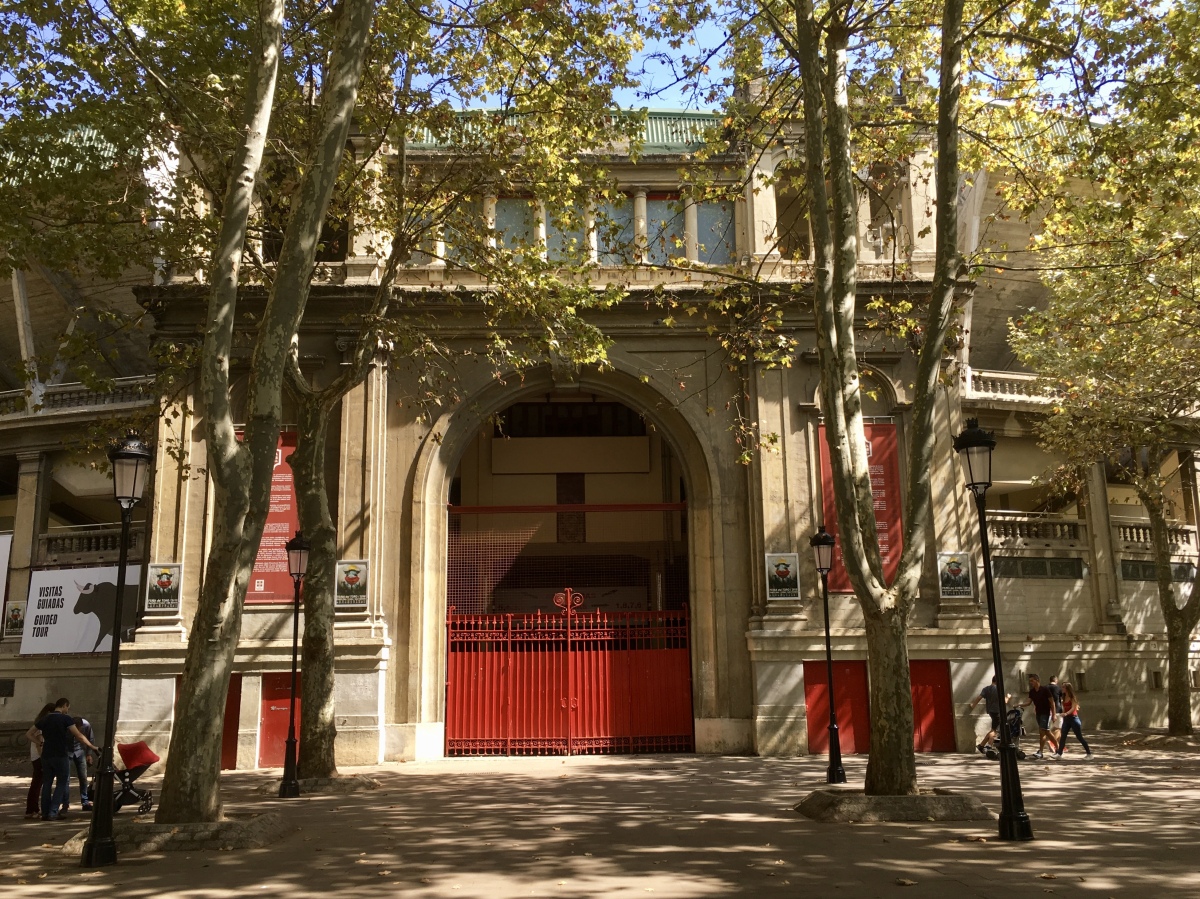
Plaza de Toros
The monument to bull running is impressively evocative and vivid with its violent and frightening details.

statue of the running of the bulls

statue of the running of the bulls
After leaving the bull running area, I got caught in another parade of huge-headed figures marching and dancing in the streets, men on fake horses flogging people with sponges attached to sticks, whole Spanish families eating tapas and drinking wine and beer, bands playing lively tunes, men in matching uniforms clearing the streets. What a lively place to be, and quite by accident!
The streets reverberated with loud music, to which the characters were dancing. Locals clapped, laughed and took pictures while having the time of their lives.

festival characters

royalty on parade
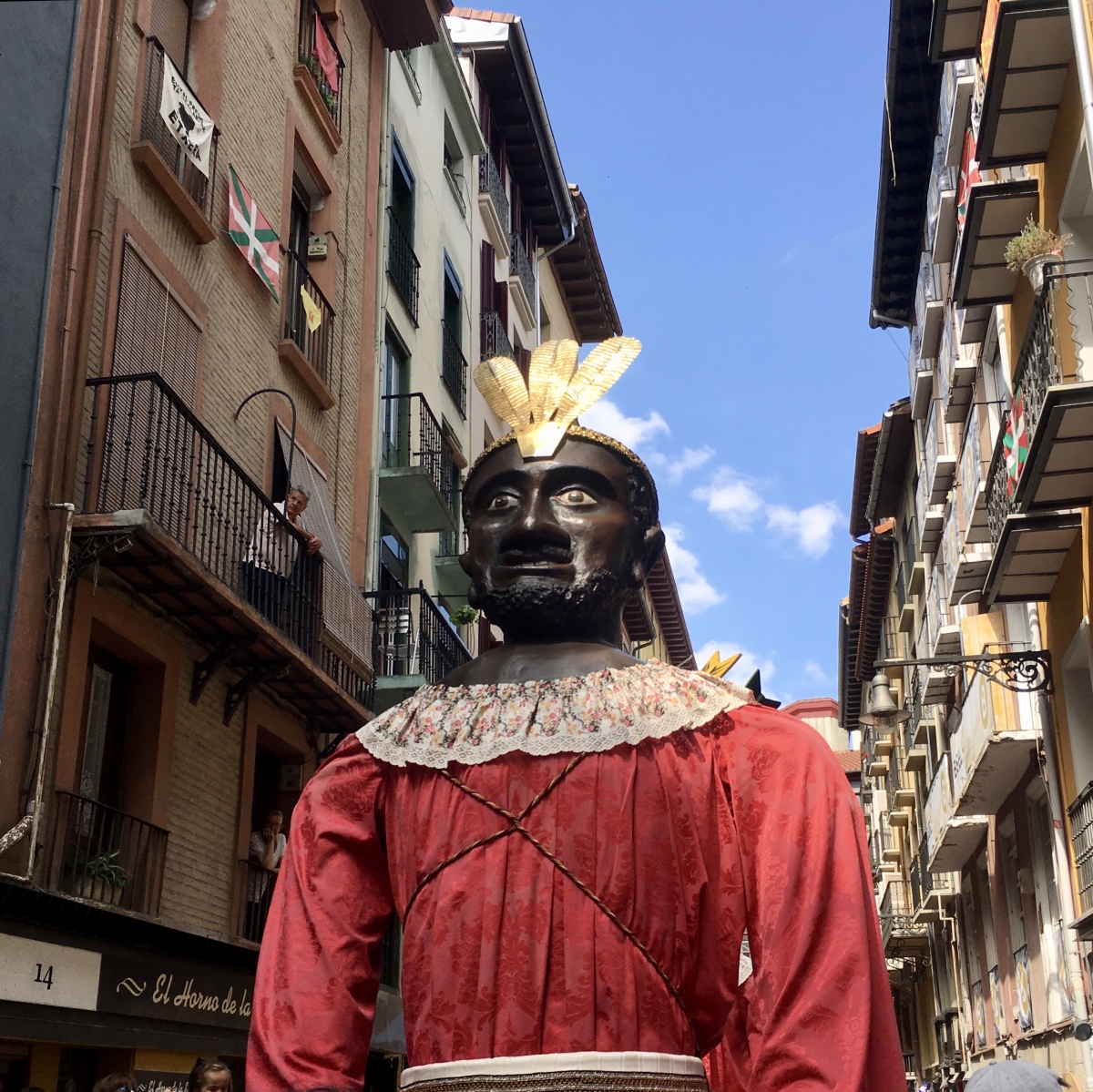
a mean-looking character
After the crowds passed, I continued wandering around the city.
I walked past the Iglesia de San Saturnino, named after the patron saint of Pamplona. Saturnin was the first evangelist of the city. Originally Romanesque in style, it is now more Gothic in appearance.

Iglesia de San Saturnino
The Citadel is the walled fortification built between 1571 and 1645 under the orders of King Felipe II of Spain, with a layout designed by an Italian military engineer. A sophisticated defensive system was devised, a rectangular pentagon, or star shape, with five bastions at the corners. The layout was supposed to make it impregnable. It is regarded as the finest example of military architecture from the Spanish Renaissance.
In the 20th century, it was converted to a park and is often used for shows and art displays.
It was quite hot walking around in the sun at the Citadel, so I sat for a while on a bench to orient myself. While looking at my guidebook pages, I saw that I would be passing the Citadel tomorrow morning on my way out of Pamplona. I was always happy to figure out my route out of a town the day before I started my walk the next morning.
I continued on through the leafy Parque de la Taconera, with its beautiful flower beds and café and past a statue back toward my albergue. After relaxing a bit, I made my way up to the city walls, where I stopped at a café for a drink and some people-watching.
I stopped into the Church of San Lorenzo, where I sat in silence for a while, offering up prayers of gratitude and supplication, asking for peace, self-fulfillment, and joy for myself and all my family and friends.

Church of San Lorenzo
It seemed I was walking around in circles and several times felt totally disoriented. The town was splashed everywhere with graffiti. The town hall, or Casa Consistorial, dominated a small square with its baroque façade.
Since the Gothic 15th century Cathedral of Santa María la Real had been closed when I dropped by earlier, I made my way back to it. It was open, but no one was manning the desk, thus I was unable to get a stamp for my credenciale. I wandered around the Cathedral, stopping to admire the alabaster mausoleum of Carlos III El Noble and his wife Leonor of Navarre, with their idealized expressions, in the main nave. The monarchs of Spain used to be crowned here, and at one time it was the seat of the parliament of Navarre.

Cathedral of Santa María
I went in search of a quiet street and dipped into the adorable Café de Pablo, where I enjoyed a tinto verrano (red wine with lemonade) and tapas – goat cheese, caramelized onions and green peppers on toast – and a jambon sandwich.

a quiet side street of colorful buildings

tapas: goat cheese, caramelized onions and green peppers on toast

Pamplona streets
I didn’t really get much “rest” during my first “rest day” on the Camino, as I walked over six miles. Early in the evening, it started raining with a vengeance, and it was predicted to be pouring in the morning, when I would walk to Muruzábal.
*Day 5: Saturday, September 8, 2018*
*14,734 steps, or 6.24 miles: wandering around Pamplona*
You can find everything I’ve written so far on the Camino de Santiago here:
**********************
On Sundays, I post about hikes or walks that I have taken in my travels; I may also post on other unrelated subjects. I will use these posts to participate in Jo’s Monday Walks or any other challenges that catch my fancy.
This post is in response to Jo’s Monday Walk: Remember Culatra?




























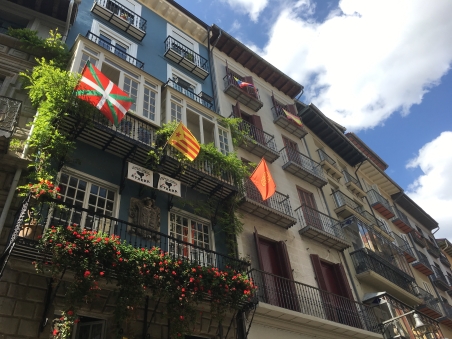



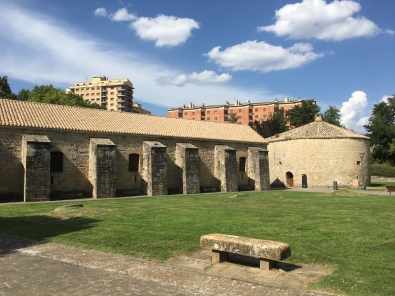











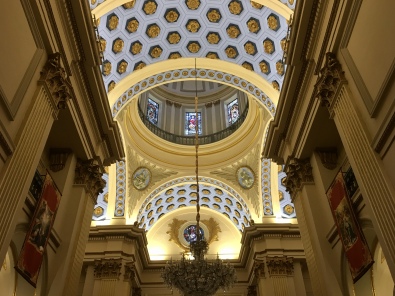


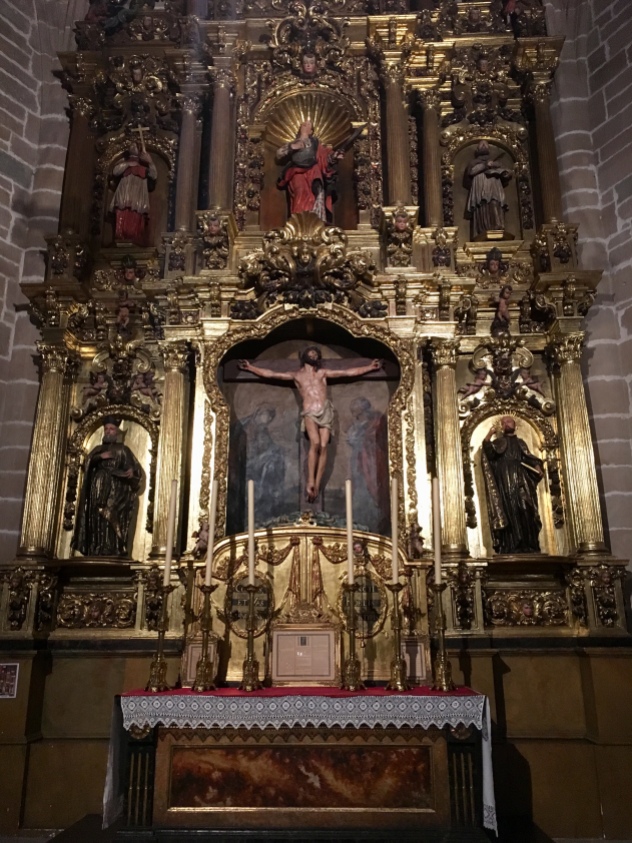


Aside from Hemingway and the bulls (those sculptures are so lifelike and fierce!), it’s not a city I know much about, Cathy, so thanks for letting me wander with you. Serious fortifications, too! I’m quite happy browsing alone and stopping when I want to (usually when I have to because my feet have given out 🙂 ). The ‘local’ walk is over in Spain today and I will be part of a big crowd, which I don’t like so much, but it’s an area I’ve not been so hopefully worth it. Have a lovely Sunday!
LikeLike
I didn’t mind wandering around alone at all, Jo, because I could stop and go whenever and wherever I felt like going. Have fun on your walk in Spain. I wouldn’t like the large group, but I’m sure it will be fun for you! Happy Sunday! 🙂
LikeLike
It was fine once we spread out, Cathy. 10 km and some people were faster than others or chose a shorter route 😍🌷🌻💕 xx
LikeLike
It always does seem to be that way when people walk together, as everyone goes at different paces. Glad you had fun. 🙂
LikeLiked by 1 person
What a busy ‘rest’ day!!! Great photos – I love the statue of the running of the bulls.
LikeLike
Thanks, Marie. I took 3 “rest days” on my entire Camino, and none of them were really rest days! I always wanted to see as much as possible and not miss anything. 🙂 I loved that statue too. Thanks for dropping by and commenting. 🙂
LikeLike
Thank you for the fabulous tour! What a fun city. Great photos of the statue of the bull running.
LikeLike
It was a very lively city. I bet it’s even more lively (or deadly) when the bulls run in July! 🙂 Thanks, Amy!
LikeLiked by 1 person
What a vibrant city! Or at least, you hit it at a vibrant time. The bull statue makes me very uncomfortable though.
LikeLike
It was very lively because of that festival, Anabel. I wouldn’t want to be there during the running of the bulls though! 🙂
LikeLiked by 1 person
I loved this wander around with you Cathy, what an interesting city. You took the bull statues at a great angle to catch the scared feeling of the fallen runners with the bulls looming over them. I think being on your own is definitely better when exploring somewhere new. You can see more.
LikeLike
I agree about being on your own to explore, Pauline. I’m glad you enjoyed my wander. That statue conveyed very well the fear of the participants!
LikeLiked by 1 person
[…] (Camino: day 5) a rest day in Pamplona […]
LikeLike
[…] https://wanderessence.com/2019/02/10/camino-day-5-a-rest-day-in-pamplona/ […]
LikeLike
A very entertaining post. I never managed to get to grips with Pamplona, I don’t know why. It somehow didn’t grip me the way other Spanish cities did/do. But how I wish we’d seen those statues of the bull running. I don’t know if they was there when I visited (in the seventies) but if they were, we somehow missed them. It’s almost worth a visit back just to see it. In fact I may try to pop over there when I’m in Bilbao in May if I can make time. Your photographs are amazing, you have a great eye for the right angle. And I envy your ability to still manage to take good pix when you are tired. I can see my tiredness reflected, always, in my images as the later the day the more lack-lustre they become and often unfocussed! Glad you had such a good day, and the food looks great.
LikeLike
Hi Mari, I don’t know why I can never connect with your blog anymore. Any time I click on your avatar or link, it takes me to strange places! Thanks for your comment about Pamplona. I liked Pamplona myself, although while walking the Camino, I found all large cities a bit grating. I don’t know when that statue of the running bulls was created, but maybe it wasn’t there in the 70s. Who knows? So you’re going to Bilbao in May? That sounds exciting. I’ve never been there, so I’ll look forward to reading your posts. The day was fun, although I didn’t get any rest whatsoever, and had a long walk ahead the next day. Thanks for your compliment about the photos too. I loved eating tapas in Pamplona; it was always a welcome relief to find some variety of good food after the bland pilgrim meals in the smaller villages. 🙂
LikeLike
You hav such great timing bein there when there’s so much going. Thanks for taking me along on your colourful colourful day.
LikeLike
Thanks for dropping by, Gilly. It was a very festive day in Pamplona. It was a bit jarring to the senses after the quiet of the Camino. I’m glad you enjoyed coming along. 🙂
LikeLike
It looks like a beautiful and very interesting city. I can’t believe you did all that walking on a rest day. 🙂
LikeLike
I don’t think I had one true rest day on the Camino, Robin. And even once Mike arrived in Portugal, we were still on the go. Only when I went to Muxía and Finisterre did I take some time to rest, mainly because by that time I was miserably sick! 🙂
LikeLike
Having a day to yourself when so many days had been spent with others sounds like a real treat, and you really made the most of it Cathy.
LikeLike
It was a really nice day!
LikeLike